Aberdeenshire folksinger Iona Fyfe has become one of Scotland’s finest young folk singers, rooted deeply in the singing traditions of the North East of Scotland. Ballads Vol. I is a six-track unaccompanied release featuring classic traditional ballads in their rawest form, created in lockdown. Proceed only if you are fond of protracted narrative songs of death and despair...

"Andrew Lammie" is Child ballad 233 (Roud 98). It is said to record a historical event, with the grave of the heroine in the churchyard at Fyvie.
Tifty’s Annie falls in love with Andrew Lammie, a lord's trumpeter. Her parents refuse permission because he is poor. He has to leave, and although he has promised fidelity and to return, she sickens. Her family, set against the match, try beatings to make her give him up, but it is unavailing. They may send to the lord accusing Andrew Lammie of bewitching her, but the lord believes his claim that it was only love.
She dies, either of a broken heart or her back broken by her brother. Her father may repent of his insistence. Usually, Andrew Lammie dies soon after.
| Album/Single | Performer | Year | Variant | Notes |
|---|---|---|---|---|
| The Bonny Birdy | Ray Fisher | 1972 | Mill O'Tifty's Annie | . |
| The Boys of the Lough | The Boys of the Lough | 1973 | Andrew Lammie | . |
| Song of the Seals | Jean Redpath | 1978 | Mill O'Tifty's Annie | . |
| Blood and Roses - vol 5 | Ewan MacColl | 1986 | Andrew Lammie | . |
| The Queen Among the Heather | Jeannie Robertson | 1998 | Bonnie Annie and Andrew Lammie | Probably the longest version - over 13 minutes. |
| The World's Room | Old Blind Dogs | 1999 | Mill O'Tifty | . |
| Alison Gross | Asonance | 2000 | Krutý bratr | Czech translation (Cruel Brother). |
| Laughing with the Moon | Hilary James & Simon Mayor | 2004 | Andrew Lammie | . |
| Women Folk | Gordeanna McCulloch | 2005 | Mill O'Tifty's Annie | . |
| Prodigal Son | Martin Simpson | 2007 | Andrew Lammie | . |
| Awkward Annie | Kate Rusby | 2007 | Andrew Lammie | . |
| A Health To The Ladies | Craig Herbertson | 2011 | Andrew Lammie | . |
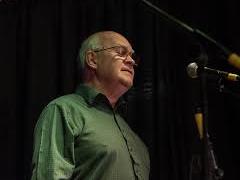

Listen to Andrew Lammie / Mill o' Tifty's Annie from: Steve Crawford & Sabrina Palm, Fling , Craig Herbertson, Hilary James, Old Blind Dogs, Fiona Ross, Kate Rusby, Martin Simpson
Watch Andrew Lammie / Mill o' Tifty's Annie from: Iona Fyfe, Fiona Ross, Sheila Stewart, Stewarts of Blairgowrie Lyrics (© Mainly Norfolk): Andrew Lammie / Mill o' Tifty's Annie

"Barbara Allen" (Child 84, Roud 54) is a traditional Scottish ballad; it later travelled to America both orally and in print, where it became a popular folk song. Ethnomusicologists Steve Roud and Julia Bishop described it as "far and away the most widely collected song in the English language—equally popular in England, Scotland and Ireland, and with hundreds of versions collected over the years in North America."
The ballad generally follows a standard plot, although narrative details vary between versions. A servant asks Barbara Allen to attend on his sick master. She visits the bedside of the heartbroken young man, who pleads for her love. She refuses, claiming that he had slighted her while drinking with friends; he dies soon thereafter. Barbara Allen later hears his funeral bells tolling; stricken with grief, she dies as well. They are buried in the same church, a rose grows from his grave, a briar from hers, the plants form a true lovers' knot.
A diary entry by Samuel Pepys on January 2, 1666 contains the earliest extant reference to the song. In it, he recalls the fun and games at a New Years party:
...but above all, my dear Mrs Knipp whom I sang; and in perfect pleasure I was to hear her sing, and especially her little Scotch song of Barbary Allen.
From this, Roud & Bishop have inferred the song was popular at that time. They suggested that it may have been written for stage performance, as Elizabeth Knepp was a professional actress, singer, and dancer.
One 1690 broadside of the song was published in London under the title "Barbara Allen's cruelty: or, the young-man's tragedy. With Barbara Allen's [l]amentation for her unkindness to her lover, and her self". Additional printings were common in Britain throughout the eighteenth century. The ballad was first printed in the United States in 1836. Many variations of the song continued to be printed on broadsides in the United States through the 19th and 20th centuries. Throughout New England, it was passed orally and spread by inclusion in songbooks and newspaper columns, along with other popular ballads such as "The Farmer's Curst Wife" and "The Golden Vanity".
Several early complete versions of the ballad are extant. Scottish poet Allan Ramsay published "Bonny Barbara Allen" in his Tea-Table Miscellany published in 1740. Soon after, Thomas Percy published two similar renditions in his 1765 collection Reliques of Ancient English Poetry under the titles "Barbara Allen's Cruelty" and "Sir John Grehme and Barbara Allen". Ethnomusicologist Francis Child compiled these renditions together with several others found in the Roxburghe Ballads to create his A and B standard versions, used by later scholars as a reference.
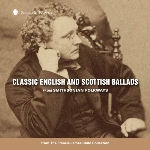
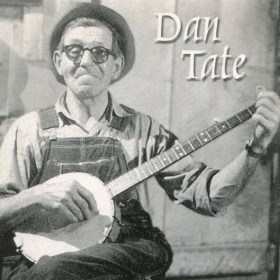
The setting is sometimes "Scarlet Town". This may be a punning reference to Reading, as a slip-song version c. 1790 among the Madden songs at Cambridge University Library has 'In Reading town, where I was bound.' London town and Dublin town are used in other versions. The dying man is called Sir John Graeme in the earliest known printings. American versions of the ballad often call him some variation of William, James, or Jimmy; his last name may be specified as Grove, Green, Grame, or another. The ballad opens by establishing a festive timeframe, usually stated as May, Martinmas, or Lammas. A dialogue between the two characters follows:
As with most folk songs, "Barbara Allen" has been published and performed under many different titles. The ballad and its heroine have in conjunction been called "The Ballet of Barbara Allen", "Barbara Allen's Cruelty", "Barbarous Ellen", "Edelin", "Hard Hearted Barbary Ellen", "Sad Ballet Of Little Johnnie Green", "Sir John Graham", "Bonny Barbara Allan", "Barbry Allen" among others.

Roger Quilter wrote an arrangement in 1921, dedicated to the noted Irish baritone Frederick Ranalow, who had become famous for his performance as Macheath in The Beggar's Opera at the Lyric Theatre, Hammersmith. Quilter set each verse differently, using countermelodies as undercurrents. An octave B with a bare fifth tolls like a bell in the fourth verse. A short piano interlude before the fifth verse was commented on favourably by Percy Grainger. Quilter later incorporated the setting in his Arnold Book of Old Songs, rededicated to his late nephew Arnold Guy Vivian, and published in 1950.
The song often concludes with poetic motif of several stanzas describing symbolising fidelity in love even after death. Standard forms of such motifs are common to several ballads, including "Lord Thomas and Fair Annet", "Lord Lovel", and "Fair Margaret and Sweet William".
The earliest recording of the song is probably a 1907 wax cylinder recording by composer and musicologist Percy Grainger of the Lincolnshire folk singer Joseph Taylor which was digitised by the British Library and made available online in 2018. Other traditional recordings include those of African American Hule "Queen" Hines of Florida (1939), Welshman Phil Tanner (1949), Irishwoman Elizabeth Cronin (early 1950s), Norfolk folk-singer Sam Larner (1958), and American folk singer Jean Ritchie (1961).

Charles Seeger edited a collection released by The Library of Congress entitled Versions and Variants of Barbara Allen from the Archive of Folk Song as part of its series Folk Music of the United States. The record compiled 30 versions of the ballad, recorded from 1933 to 1954 in the United States.
Baritone vocalist Royal Dadmun released a version in 1922 on Victor Records. The song is credited to the arrangers, Eaton Faning and John Liptrot Hatton.
Versions of the song were recorded in the 1950s and '60s by folk revivalists, including Pete Seeger. Eddy Arnold recorded and released a version on his 1955 album “Wanderin’.” The Everly Brothers recorded and released a version on their 1958 folk album, "Songs Our Daddy Taught Us." Joan Baez released a version in 1961, the same year as Jean Ritchie's recording. Bob Dylan said that folk songs were highly influential on him, writing in a poem that "[w]ithout "Barbara Allen there'd be no 'Girl From the North Country'; Dylan performed a live eight-minute rendition in 1962 which was subsequently released on Live at The Gaslight 1962.
The ballad was covered as a demo version by Simon and Garfunkel on their anthology album The Columbia Studio Recordings (1964-1970) and a bonus track on the 2001 edition of their album Sounds of Silence as "Barbriallen", and by Art Garfunkel alone in 1973 on his album Angel Clare.
Angelo Branduardi covered this song as Barbrie Allen resp. Barbriallen on his two music albums Cosi e se mi pare – EP " and Il Rovo e la rosa in Italian. On his French EN FRANÇAIS – BEST OF compilation in 2015 he sang this song in French-adaption written by Carla Bruni.
English singer-songwriter Frank Turner often covers the song a cappella during live performances. One rendition is included on the compilation album The Second Three Years.
UK folk duo Nancy Kerr & James Fagan included the song on their 2005 album Strands of Gold, and also on their 2019 live album An Evening With Nancy Kerr & James Fagan.
The song has been adapted and retold in numerous non-musical venues. Howard Richardson and William Berney's 1942 stage play Dark of the Moon is based on the ballad, as a reference to the influence of English, Irish and Scottish folktales and songs in Appalachia. It was also retold as a radio drama on the program Suspense, which aired October 20, 1952, and was entitled "The Death of Barbara Allen" with Anne Baxter in the titular role. A British radio play titled Barbara Allen featured Honeysuckle Weeks and Keith Barron; it was written by David Pownall and premiered on BBC Radio 7 on February 16, 2009.
The song has also been sampled, quoted, and featured as a dramatic device in numerous films:


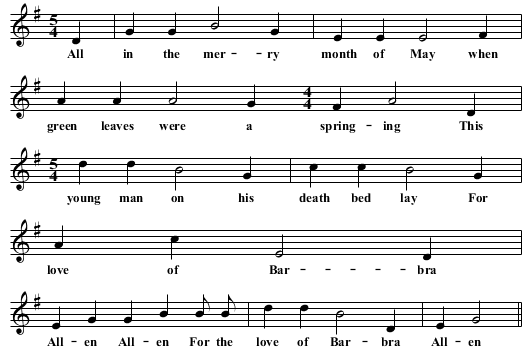
Listen to Barbara Allen from: Blackmore's Night, Blue Horses, Rose Laughlin, Lilly Bros, Frank Luther, Findlay Napier, Jean Ritchie, Alasdair Roberts, Martin Simpson, Steve Tilston, Lucy Wainwright Roche, Hedy West
Watch Barbara Allen from: Bluehorses, James Findlay, Iona Fyfe, Nancy Kerr, Ye Vagabonds Lyrics (© Mainly Norfolk): Barbara Allen / Barbary Allen / Barbary Ellen

The Jolly Beggar, also known as The Gaberlunzieman, is Child ballad 279. The song's chorus inspired lines in Lord Byron's poem "So, we'll go no more a roving".

A beggar comes over the hills one day, and knocks on the door of a local farmer and asks for a roof for the night. Curiously, he will not accept a bed in the barn, but wishes only to sleep by the kitchen fire. Late at night, the farmer's daughter comes down to lock the kitchen door. The beggar and daughter exchange words, and fall in love. They sleep together, and through some unmentioned premise, the daughter accuses the man of being a nobleman come dressed as a beggar to woo her. He convinces her that he is indeed only a beggar, and she kicks him out. However, it turns out he was, in fact, a noble.
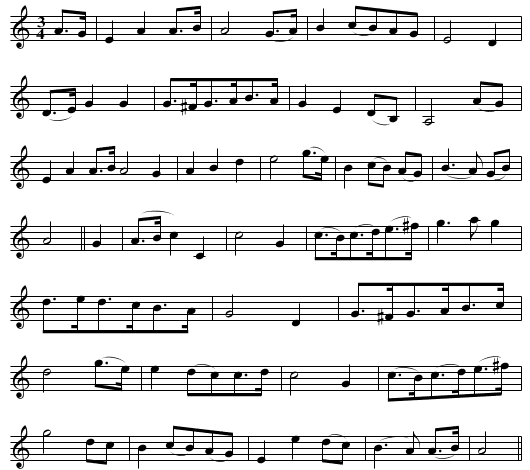
Listen to The Jolly Beggar / The Gaberlunzieman from: Broom Bezzums, Ceolbeg, James Findlay, Kilshannig, Pressgang, Lissa Schneckenburger, Seldom Sober Company, June Tabor
Watch The Jolly Beggar / The Gaberlunzieman from: Iona Fyfe, Andy Irvine, Planxty, Jean Redpath Lyrics (© Mainly Norfolk): The Beggar Man / The Auld Beggarman / The Jolly Beggar
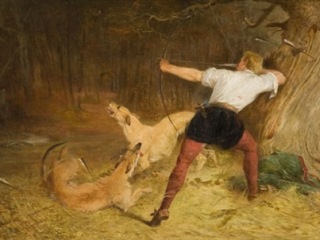
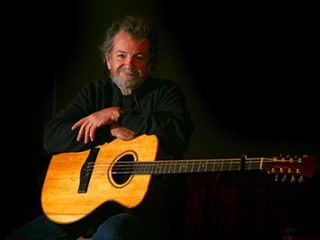
Johnie Cock (also Johnny O'Breadisley or Jock o' Braidislee) is the 114th Child Ballad, existing in several variants. The Child Ballads were a collection of 305 ballads from England and Scotland, collected by Francis James Child in the late 19th century.
Johnie Cock is warned by his mother that he is in danger but nevertheless goes poaching and kills a deer. He feeds his dogs and sleeps in the woods. A man (sometimes a palmer, a medieval European pilgrim to the Holy Land) betrays him to foresters, who attack him while he sleeps. Johnie wakes. Either he or his nephew rebukes them for the attack, in most variants saying that even a wolf would not have attacked him like that. In most variants, he fights and kills all of his assailants but one, whom he wounds.
In several versions, he dies of his wounds while still in the wood. In one variant, he is laid low, and the king sends him a pardon.

Listen to Johnie Cock / Johnny O'Breadisley from: Jeana Leslie & Siobhan Miller, Old Blind Dogs, June Tabor
Watch Johnie Cock / Johnny O'Breadisley from: The Corries, Iona Fyfe, Top Floor Taivers/a> Lyrics (© Mainly Norfolk): Johnie Cock / Johnny the Brine / Johnny o' Bredislee


Edom o Gordon or Captain Car (Child #178, Roud #80) is a traditional Scottish ballad that exists in several versions. The ballad recounts the gruesome events of Gordon's (or, in some versions, Car's) burning down of his enemy's castle that killed the lady of the house, her children and most of the servants.
Edom o Gordon (or Captain Car) and his men need shelter from the cold weather of Martinmas and decide to seek it at the house of the Rodes. When the lady of the castle sees the troops arriving, she is disappointed that they are not those of her returning husband, but his enemy's. She climbs to the top of the tower and tries to negotiate with Gordon (or Car), but he demands that she open up the castle and, worse still, sleep with him. After she refuses, he vows to burn down the building with her three children still inside. To achieve this, he offers one of the servants, Jock, a fee for his help. He agrees and the fire is started. Attempting to save the youngest daughter, the lady throws some sheets down so that the besiegers might catch the baby but, instead, when she is thrown from the blaze, Gordon (or Car) impales her on the end of his spear.
While these grisly events are unfolding, the lord of the manor arrives and rushes over to the castle to save his wife and children but he is too late – they are all dead. He sets his own troops to battle those of his enemy and, from the ensuing battle, only five of Gordon's (or Car's) original fifty men return home.
The first printing of "Edom o Gordon" was in 1755 by Robert and Andrew Foulis. The story is thought to document a real historical event of 1571 as told in The Diurnall of Occurents (1755), although some of the details are speculative. Edom o Gordon is usually identified as Adam Gordon of Auchindoun, supporter of Mary, Queen of Scots, Captain Car as Captain Kerr, one of his lieutenants, and the lady of the castle as Margaret Forbes (née Campbell) of the Forbes clan (supporters of James VI and the Gordon clan's arch-enemies). The castle is thought not to be Rhodes Castle but the House of Towie (Toway) at Corgarff.

Listen to Edom o Gordon from: Malinky
Watch Edom o Gordon from: Iona Fyfe, Alison McMorland Lyrics (© Mainly Norfolk): Edom o Gordon
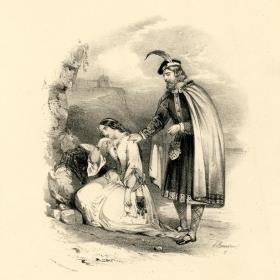

John of Hazelgreen or Jock O'Hazeldean is Child ballad 293. Jock o'Hazeldean was a poem based on a fragment of the ballad by Sir Walter Scott. Versions of the ballad were published by Chambers, Kinloch and Buchan. The version printed by John S. Roberts (1887) was compiled from those of Kinloch and Buchan.
A man asks a maid why she is weeping; it is for the love of John of Hazelgreen. He offers to marry her to his oldest, or youngest, son if she will forsake him, and she refuses. Nevertheless, he takes her with him, and he proves to be John of Hazelgreen's father, and informs his son that he is marrying her that day.
The Jock of Hazeldean version has a different plot. The father of the groom tries to reconcile the woman to marrying his son, but she is utterly passive in the face of her prospective father-in-law's enticements, replying only by weeping. However, at the very end of the song, she turns out to have been playing a waiting game; she has disappeared with her lover Jock O'Hazeldean, eloping across the English-Scottish border.

Listen to Jock o' Hazeldean from: Annie Grace, Jim Malcolm, Maddy Prior, Ian Smith
Watch Jock o' Hazeldean from: The Corries, Barbara Dickson, Gary Lightbody, Jim Malcolm, Jim Moray, Maddy Prior Lyrics (© Mainly Norfolk): John of Hazelgreen / Jock o' Hazeldean

Text is available under the Creative Commons Attribution-ShareAlike License.
Date: October 2020.
Photo Credits:
(1),(2),(19) Iona Fyfe,
(3) Dougie Mackenzie,
(4) Fiona Ross,
(6) Barbara Allen,
(7) Dan Tate,
(8) Martin Simpson,
(9) Hedy West,
(11) James Findlay,
(12) The Gaberlunzie Man,
(15) Andy Irvine,
(16) Johnny of Braidislee (Samuel Edmund Waller),
(17) Edom o Gordon,
(19) Maddy Prior,
(20) John of Hazelgreen
(unknown/website);
(5) 'Andrew Lammie',
(10) 'Barbara Allen',
(14) 'The Jolly Beggar',
(17) 'Johnie Cock',
(21) 'John of Hazelgreen'
(by ABC Notations);
(13) June Tabor,
(18) Malinky
(by Walkin' Tom).